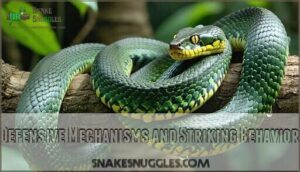This site is supported by our readers. We may earn a commission, at no cost to you, if you purchase through links.

These non-venomous constrictors use heat-sensing pits to hunt birds and small mammals at night, hanging in S-shaped coils from branches like living sculptures.
They’re known for their striking color patterns and sometimes feisty temperament – definitely not your typical beginner snake.
In captivity, they need high humidity, plenty of climbing space, and careful temperature control to thrive.
Their prehensile tails and aggressive hunting style make them fascinating to observe, though proper setup and understanding their unique needs are essential for success.
Table Of Contents
- Key Takeaways
- Amazon Tree Boa Basics
- Physical Characteristics
- Amazon Tree Boa Behavior
- Care and Housing
- Comparison and Conservation
- Frequently Asked Questions (FAQs)
- What is the Amazon tree boa?
- How to care for Amazon tree boa?
- Where do Amazon tree boas live?
- How do Amazon tree boas hunt?
- Are Amazon tree boas aggressive?
- Do Amazon tree boas make good pets?
- Are Amazon tree boas easy to care for?
- What do Amazon tree boas eat?
- How long do Amazon tree boas live?
- Are Amazon tree boas venomous?
- Conclusion
Key Takeaways
- You’ll need specialized care requirements including 70-90% humidity, temperatures between 78-88°F, and plenty of vertical climbing space to replicate their natural rainforest canopy habitat.
- They’re not beginner-friendly pets due to their defensive temperament, complex setup needs, and potential for striking – you’ll need extensive reptile experience to handle them safely.
- You’ll observe fascinating nocturnal hunting behaviors as they use heat-sensing pits to detect warm-blooded prey while positioned in S-shaped coils on branches.
- They’re non-venomous constrictors from South America’s Amazon basin that can live up to 15 years in captivity with proper care and reach 4-7 feet in length.
Amazon Tree Boa Basics
You’ll find Amazon tree boas thriving in the humid rainforests of South America, where they’ve perfectly adapted to life high in the forest canopy.
These remarkable serpents require specific temperature and humidity conditions that mirror their native Amazon basin environment to stay healthy in captivity, and they are truly remarkable creatures.
Native Regions in South America
You’ll find amazon tree boas across South America’s vast Amazon Basin, stretching through nine countries including Brazil, Colombia, and Peru.
These tropical rainforests provide the perfect home, with populations thriving from sea level to 1,000-meter elevation ranges.
Habitat diversity within the Amazon rainforest supports regional subspecies, though deforestation poses significant conservation impact challenges for these remarkable serpents.
Preferred Arboreal Lifestyle
Your amazon tree boa’s mastery of arboreal movement transforms every branch into a highway.
These tree dwelling snakes select sturdy branches at ideal canopy height, using their prehensile tail like an anchor.
Their arboreal lifestyle offers camouflage benefits and predator avoidance while they navigate through dense foliage with surprising grace and precision.
Climate and Humidity Requirements
Your Corallus hortulanus needs tropical conditions matching its Amazon basin origins.
Maintain high humidity levels between 70-90% through regular enclosure misting and monitoring equipment.
Create temperature gradients with basking spots at 85-88°F and cooler areas around 78-80°F.
These arboreal regions experience minimal seasonal variation, so consistent warmth and moisture year-round keeps your Amazon tree boa healthy and comfortable in its natural environment.
Typical Forest Canopy Behaviors
You’ll spot these snakes positioning themselves in signature S-shaped coils on branches, using their prehensile tail like an anchor while waiting for prey.
Their camouflage techniques make them nearly invisible against bark and leaves.
These nocturnal hunters employ sit-and-wait strategies, relying on heat-sensing abilities to detect warm-blooded targets moving through the canopy darkness around them.
Maintaining proper boa humidity is essential for their overall health and well-being.
Physical Characteristics
Amazon tree boas display remarkable physical diversity that makes each individual unique in appearance.
You’ll notice these medium-sized serpents typically reach 4-7 feet in length, with females generally growing larger than their male counterparts.
Size Range and Growth Patterns
Your Amazon Tree Boa will reach its Adult Length of 4-7 feet within 2-3 years.
This arboreal snake species shows distinct Growth Rate patterns and Sexual Dimorphism.
- Juvenile Size starts at 12-24 inches with faster initial growth
- Weight Variation ranges from 200-800 grams when fully mature
- Snake Breeding reveals females typically grow larger than males
This boa constrictor’s snake morphs don’t affect size substantially.
Color Variations and Patterns
You’ll find these serpents showcase nature’s artistic flair through remarkable Color Morphs ranging from earthy browns and grays to striking reds, oranges, and yellows.
Corallus hortulana displays incredible Pattern Aberrations with spots, bands, and ellipsoid shapes creating perfect Camouflage Purposes.
Genetic Influence determines these vibrant colors, while Regional Differences across the Amazon basin produce unique snake patterns that make identification both challenging and fascinating.
Body Structure and Adaptations
Your Amazon Tree Boa’s morphology showcases remarkable arboreal adaptations that make them masters of the rainforest canopy.
Their Prehensile Tail acts like a fifth limb, while specialized Heat Pits containing infrared receptors help them hunt warm-blooded prey in darkness.
- Prehensile Tail: Functions as an anchor point, allowing secure positioning on branches while hunting
- Heat Pits: Infrared receptors along the lips detect prey’s body heat with incredible precision
- Constriction Strength: Powerful muscles enable them to squeeze prey effectively despite their slender build
- Color Camouflage: Vibrant colors and patterns provide perfect concealment among leaves and bark
Differences Between Males and Females
You’ll notice distinct Size Dimorphism between males and females when examining your Amazon Tree Boa.
Females grow larger, reaching 6-7 feet versus males’ 5-6 feet, with 40-60% greater weight at sexual maturity.
Males develop longer tails and hemipenal bulges near their cloaca.
During mating behavior, females show increased aggression while males actively roam seeking mates.
Growth Rate differs too—males mature faster at 2-3 years compared to females’ 3-4 years, though Lifespan Variance remains minimal under proper care, with notable differences in Growth Rate and overall mating behavior.
Amazon Tree Boa Behavior
You’ll discover that Amazon tree boas are fascinating nocturnal hunters with complex behavioral patterns that directly impact their care needs.
Understanding their natural instincts helps you create proper housing conditions and handle these remarkable serpents safely.
Nocturnal Hunting Habits
During nighttime hours, these nocturnal snakes become active hunters, using heat detection through specialized pits to locate warm-blooded prey in complete darkness.
Their ambush predation strategy involves positioning themselves in an S-shape on branches, waiting patiently for birds and small mammals.
Once prey approaches, they strike quickly and use prey suffocation through constriction, demonstrating remarkable hunting strategies perfected over millions of years.
Ensuring proper humidity is key, and a sphagnum moss hide can aid in shedding, which is an important aspect of their bioactive environment.
Interaction With Humans and Handling
While Amazon tree boas can become manageable reptile pets, their Temperament Variation means each snake responds differently to human contact.
Handling Safety requires understanding Bite Risk, especially before Captive Acclimation occurs. Human Impact affects their stress levels substantially, making gradual introduction to exotic pet ownership essential for successful snake care.
Key handling considerations:
- Start slow – Allow 1-2 weeks for your new exotic pets to settle before attempting contact
- Read body language – S-shaped coiling indicates stress and potential striking behavior
- Support properly – Use both hands to distribute weight, avoiding sudden movements that trigger defensive responses
Defensive Mechanisms and Striking Behavior
When threatened, your Amazon tree boa transforms into a defensive powerhouse.
They’ll coil into an S-shape, ready to strike with lightning speed.
If cornered, they’ll form a protective ball with their head tucked inside.
As a last resort, these ambush predators release cloacal discharge – nature’s stink bomb.
Their camouflage helps them avoid confrontation entirely during nocturnal hunting sessions.
Social Behavior in The Wild
Amazon tree boas are solitary creatures who prefer living alone in the rainforest canopy.
You’ll rarely see Group Dynamics since they only gather during Mating Rituals, when males compete for females through tactile courtship rather than flashy displays.
Their animal behavior reflects Predator Avoidance strategies:
- Nocturnal habits minimize encounters with birds of prey during daylight hours
- Scent-marking prevents territorial overlap with other boas
- Juvenile Independence means young snakes disperse quickly after birth.
Snake behavior shows minimal Interspecies Interactions beyond opportunistic foraging strategies around prey-rich areas.
Care and Housing
Proper housing creates the foundation for your Amazon tree boa’s health and happiness in captivity.
You’ll need to replicate their natural rainforest environment with careful attention to temperature, humidity, and space requirements, which is crucial for their overall happiness.
Enclosure Setup and Size Requirements
Your pet snake needs an Enclosure Size of at least 40 gallons for adults, with secure ventilation and locks.
Choose Substrate Options like cypress mulch or paper towels for easy cleaning.
Install sturdy Climbing Branches at various heights since these arboreal snakes love vertical space.
Provide multiple Hiding Spots using cork bark or commercial hides.
Consider enclosure product options for your boa.
Include a large Water Source for drinking and humidity in your snake habitat setup.
Temperature and Humidity Control
Creating the perfect tropical terrarium environment requires precise temperature and humidity control to mimic your snake’s natural habitat.
You’ll need heating gradients, consistent humidity levels, and reliable monitoring equipment to help your tree boa thrive. A vital component for maintaining these conditions is a reliable heat source.
- Temperature gradients: Maintain 78-82°F basking spots with 72-76°F cool zones
- Humidity levels: Keep 70-80% humidity using substrate misting and water bowls
- Monitoring equipment: Install digital thermometers and hygrometers for accurate readings
- Seasonal adjustments: Provide shedding assistance during molting periods with increased moisture
Feeding Schedule and Prey Types
Your snake’s feeding schedule requires careful attention to prey size and feeding frequency.
Adult Amazon tree boas eat every 10-14 days, while juveniles need food every 5-7 days.
Choose frozen vs. live prey based on safety—frozen reduces injury risk.
Offer prey weighing 10-15% of your snake’s body weight.
Dietary variety including mice, rats, and occasional chicks mimics their carnivorous nature and predator-prey dynamics, supporting healthy food habits and snake diet.
To prevent overfeeding, verify prey matches growth
Health Monitoring and Common Issues
Regular health checks protect your snake from common threats.
Watch for lethargy and appetite changes—early warning signs of illness.
Respiratory infections show through wheezing and mouth-breathing, requiring immediate vet attention.
Scale rot appears as discolored belly scales from excess moisture.
Internal parasites cause weight loss and regurgitation.
Shedding problems indicate poor humidity levels.
Obesity results from overfeeding, shortening your pet’s lifespan.
Proper reptile husbandry prevents most issues.
Providing appropriate snake heating solutions is essential for their well-being.
Comparison and Conservation
When you’re considering an Amazon tree boa, it’s helpful to understand how they compare to other popular pet snakes.
This knowledge will help you make informed decisions about ownership while supporting responsible breeding practices that don’t impact wild populations, and understand the conservation challenges they face in the wild.
Physical Appearance Comparisons
Distinguishing Corallus hortulanus from other Amazonian snakes becomes easier when you know their key traits.
These polychromatic beauties showcase remarkable color morphs ranging from vibrant yellows to deep browns.
Their triangular head shape and heat-sensing pits create a distinctive physical description that sets them apart from similar species.
| Feature | Amazon Tree Boa | Other Tree Boas | Ground Pythons |
|---|---|---|---|
| Color Patterns | Polychromatic with dorsoventrally arranged ellipsoid spots in dark brown, yellow, or cream | More uniform coloration with simple banding | Darker earth tones with geometric patterns |
| Scale Characteristics | Smooth scales with distinctive heat-sensing pits on lips | Keeled scales, fewer sensory pits | Heavily keeled scales, no facial pits |
| Head Shape | Triangular with pronounced neck distinction | More elongated, less defined neck | Broad, flattened appearance |
| Size Dimorphism | Females larger (5-7 feet), males smaller (4-5 feet) | Minimal sexual size differences | Significant female size advantage |
| Pattern Variations | Snake colors include spots, bands, speckles in multiple arrangements | Consistent striping or solid coloration | Bold, contrasting geometric designs |
Behavioral Differences
Understanding behavioral differences helps you appreciate what makes Amazon tree boas unique among serpents.
These snakes exhibit distinct Activity Patterns and Hunting Strategies that set them apart from ground-dwelling species.
| Behavior Category | Amazon Tree Boa | Ground-Dwelling Snakes |
|---|---|---|
| Activity Patterns | Primarily nocturnal, peak during moonless nights | Variable timing, often diurnal |
| Hunting Strategies | Ambush predator in S-coil position | Active foraging or ambush on ground |
| Social Interactions | Solitary except during breeding | Generally solitary year-round |
| Defensive Behaviors | S-coiling, striking, ball posture | Fleeing, hiding, or aggressive displays |
| Reproductive Behavior | Complex courtship behavior with ontogenetic changes in prey preference | Simpler mating rituals, consistent diet |
These predators show remarkable adaptability, switching between sit-and-wait tactics and active foraging based on prey availability and environmental conditions.
To minimize stress, it’s important to understand their defensive striking patterns.
Habitat Preferences
Throughout the Amazon basin and South America, these tropical species occupy diverse environments from forest canopy to river margins.
They thrive at elevation ranges from sea level to 900 meters, adapting to both pristine rainforest and human modified landscapes.
Habitat destruction threatens their natural homes.
| Habitat Type | Humidity Levels | Location |
|---|---|---|
| Primary Rainforest | 80-95% | Forest Canopy |
| Secondary Growth | 70-85% | River Margins |
| Modified Areas | 60-80% | Human Settlements |
Care Requirements as Pets
Dedication to proper pet care transforms Amazon tree boas into rewarding exotic animals.
These temperamental reptiles need specialized reptile supplies and experienced Handling Techniques.
Shedding Issues require monitoring, while Veterinary Care addresses health concerns in the pet trade.
| Care Aspect | Requirement | Frequency |
|---|---|---|
| Enclosure Enrichment | Branches, plants, hiding spots | Monthly rotation |
| Health Checks | Weight, skin, behavior monitoring | Weekly |
| Professional Care | Exotic veterinary examinations | Annually |
Temperament Variations between individuals affect pet snakes’ suitability for different owners.
Conservation Status and Threats
While you’ll enjoy keeping these beautiful snakes as pets, you’re also supporting wildlife conservation efforts.
Amazon tree boas face mounting threats from habitat loss, climate change, and illegal pet trade activities.
Deforestation has eliminated over 17% of suitable canopy habitats since 2000, while altered rainfall patterns affect prey availability and genetic diversity across fragmented populations.
| Threat Category | Impact Level | Conservation Response |
|---|---|---|
| Habitat Loss | High – 17% reduction | Protected areas cover 45% of range |
| Pet Trade | Moderate – 6% population loss | CITES Appendix II listing |
| Climate Change | Increasing – 12% range reduction by 2040 | Habitat restoration projects |
| Forest Fires | Variable – drought dependent | Drone monitoring systems |
| Genetic Isolation | Moderate – fragmented populations | International genetic studies |
The conservation efforts include protecting protected areas that cover 45% of the range, CITES Appendix II listing to regulate the pet trade, and habitat restoration projects to combat climate change.
Frequently Asked Questions (FAQs)
What is the Amazon tree boa?
You’ll find the Amazon tree boa is a medium-sized, arboreal snake from South America’s rainforests. It’s a constrictor with vibrant colors, heat-sensing abilities, and nocturnal hunting habits.
How to care for Amazon tree boa?
You’ll need a humid terrarium with temperatures between 78-85°F, proper lighting, and secure branches for climbing. Feed appropriately-sized prey every 1-2 weeks and maintain 70-80% humidity levels consistently.
Where do Amazon tree boas live?
Ever wondered where these rainbow-colored serpents call home?
You’ll discover Amazon tree boas throughout South America’s rainforests, from Bolivia to Venezuela, thriving in humid canopies 1-25 meters above ground near rivers.
How do Amazon tree boas hunt?
You’ll watch Amazon tree boas hunt as ambush predators, positioning themselves in an "S" shape on branches.
They’re primarily nocturnal hunters using heat-sensing pits and sharp eyesight to detect prey, then constricting victims.
Are Amazon tree boas aggressive?
Like gentle giants wrapped in vibrant armor, these serpents aren’t naturally aggressive toward humans.
They’re primarily focused on hunting birds and small mammals peacefully, and you’ll find them defensive when threatened.
Using S-coiling, striking, or balling up protectively, but they’re primarily focused on their natural prey rather than humans.
Do Amazon tree boas make good pets?
Amazon tree boas aren’t ideal beginner pets.
They’re defensive, requiring specialized humidity, temperature, and arboreal setups.
You’ll need extensive reptile experience, proper handling techniques, and significant time investment for their complex care requirements.
Are Amazon tree boas easy to care for?
You’ll find these snakes challenging to care for.
They require precise humidity levels, specific temperatures, and can be quite defensive.
Their complex needs make them better suited for experienced reptile keepers.
What do Amazon tree boas eat?
You’ll feed them birds, small mammals, and occasionally lizards in captivity. Juveniles eat frogs and smaller prey, while adults prefer larger birds and mammals exclusively.
How long do Amazon tree boas live?
You’ll discover these fascinating constrictors live up to 15 years in the wild, though captive specimens can exceed this lifespan with proper care and ideal husbandry conditions.
Are Amazon tree boas venomous?
No, you don’t need to worry about venom with these snakes. Amazon tree boas are non-venomous constrictors that kill prey by wrapping around and suffocating them, not through toxic bites.
Conclusion
Like a perfectly coiled spring ready to strike, your amazon tree boa represents one of nature’s most specialized arboreal hunters.
You’ve learned that successful care requires replicating their rainforest environment with high humidity, proper temperatures, and extensive climbing opportunities.
Remember that these snakes aren’t beginner-friendly pets – they demand respect, careful handling, and dedicated setup.
With proper preparation and understanding of their nocturnal hunting behaviors, you’ll enjoy observing one of South America’s most fascinating serpents thrive in captivity, and appreciate their unique place as one of nature’s most fascinating serpents.
- https://www.reptco.co.uk/images/files/Amazon%20Tree%20Boa%20Caresheet.pdf
- https://findyourreptile.com/reptile-info/arboreal-boa-articles/amazon-tree-boa-care-sheet-expert-tips-for-optimal-health/
- https://bjvp.org.br/wp-content/uploads/2015/07/DOWLOAD-FULL-ARTICLE-06-20881_2014_7_31_58_46.pdf
- https://www.thebiodude.com/blogs/snake-caresheets/amazon-tree-boa-corallus-hortulanus-care-sheet
- https://darrenhamillreptiles.com/amazon-tree-boa-husbandry/
















